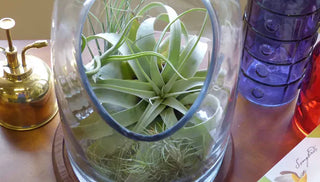Traditional potted plants are not the only way to invite greenery into your home. If you are short on space or want to skip filling a hefty planter with tons of soil, try these "other ways" to garden!
4 Indoor Garden Alternatives to Potted Plants

1. Waxed Amaryllis Bulbs
The ultimate no-maintenance plant, waxed bulbs require no soil and no water. Set them in a bright room and wait for massive, magnificent blooms to appear. Their soil-free and water-free lifestyle makes them ideal gifts for hospital residents and The wax coating prohibits them from growing after the first flower, but if you peel off the wax and plant in a pot of fresh growing medium, you can get many additional seasons of blooms.

2. Air Plants
These tropical plants are epiphytes, meaning that they do not root into soil, but instead perch (harmlessly) on other plants and absorb nutrients from their surroundings. Air plants can be tucked in a soilless terrarium, displayed on a bookcase, or hung in a steamy bathroom — provided they get plenty of humidity, air plants are extremely versatile.

3. Microgreens
Ok, they will need SOME soil, but only a very small amount. Also known as "vegetable confetti," microgreens are simply immature greens, typically ready for harvest in as little as 10-21 days! Popular microgreens types include radish, arugula, broccoli, and basil. Seeds can be sown in a shallow dish on just an inch or two of growing medium, and then placed under a grow light. Mist your micros regularly and then harvest with a set of snips. Microgreens are delicious in salads, or as a zesty garnish.

4. Terrariums
With a glass container and a small amount of gravel or coir, you can create a mini mossy woodland, display tiny tropicals, or design a delightful tabletop fairy garden using plants and found objects, such as pebbles and sea glass. Houseplants that stay small in stature, like polka dot plant or hens and chicks, are perfect terrarium tenants.
Let There Be Light
You may be able to ditch the soil or do only occasional watering, but no plant will survive in total darkness. The average windowsill can support most low-light houseplants, however if you want to germinate microgreens or grow light-loving succulents, you'll need a boost from a full-spectrum grow light. This is especially true in winter months, when natural light levels are low and day lengths are short, as most plants enjoy at least 6 hours of bright light, and seedlings require at least double that. Learn how to garden indoors with grow lights.





